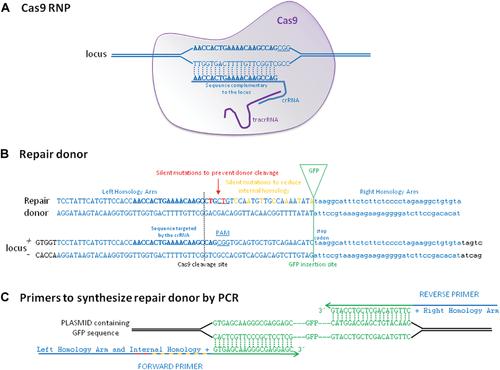{"title":"Rapid Tagging of Human Proteins with Fluorescent Reporters by Genome Engineering using Double-Stranded DNA Donors","authors":"Alexandre Paix, Dominique Rasoloson, Andrew Folkmann, Geraldine Seydoux","doi":"10.1002/cpmb.102","DOIUrl":null,"url":null,"abstract":"<p>Tagging proteins with fluorescent reporters such as green fluorescent protein (GFP) is a powerful method to determine protein localization, especially when proteins are tagged in the endogenous context to preserve native genomic regulation. However, insertion of fluorescent reporters into the genomes of mammalian cells has required the construction of plasmids containing selection markers and/or extended sequences homologous to the site of insertion (homology arms). Here we describe a streamlined protocol that eliminates all cloning steps by taking advantage of the high propensity of linear DNAs to engage in homology-directed repair of DNA breaks induced by the Cas9 RNA-guided endonuclease. The protocol uses PCR amplicons, or synthetic gene fragments, with short homology arms (30-40 bp) to insert fluorescent reporters at specific genomic locations. The linear DNAs are introduced into cells with preassembled Cas9-crRNA-tracrRNA complexes using one of two transfection procedures, nucleofection or lipofection. The protocol can be completed under a week, with efficiencies ranging from 0.5% to 20% of transfected cells depending on the locus targeted. © 2019 The Authors.</p>","PeriodicalId":10734,"journal":{"name":"Current Protocols in Molecular Biology","volume":"129 1","pages":""},"PeriodicalIF":0.0000,"publicationDate":"2019-09-19","publicationTypes":"Journal Article","fieldsOfStudy":null,"isOpenAccess":false,"openAccessPdf":"https://sci-hub-pdf.com/10.1002/cpmb.102","citationCount":"7","resultStr":null,"platform":"Semanticscholar","paperid":null,"PeriodicalName":"Current Protocols in Molecular Biology","FirstCategoryId":"1085","ListUrlMain":"https://onlinelibrary.wiley.com/doi/10.1002/cpmb.102","RegionNum":0,"RegionCategory":null,"ArticlePicture":[],"TitleCN":null,"AbstractTextCN":null,"PMCID":null,"EPubDate":"","PubModel":"","JCR":"Q2","JCRName":"Biochemistry, Genetics and Molecular Biology","Score":null,"Total":0}
引用次数: 7
Abstract
Tagging proteins with fluorescent reporters such as green fluorescent protein (GFP) is a powerful method to determine protein localization, especially when proteins are tagged in the endogenous context to preserve native genomic regulation. However, insertion of fluorescent reporters into the genomes of mammalian cells has required the construction of plasmids containing selection markers and/or extended sequences homologous to the site of insertion (homology arms). Here we describe a streamlined protocol that eliminates all cloning steps by taking advantage of the high propensity of linear DNAs to engage in homology-directed repair of DNA breaks induced by the Cas9 RNA-guided endonuclease. The protocol uses PCR amplicons, or synthetic gene fragments, with short homology arms (30-40 bp) to insert fluorescent reporters at specific genomic locations. The linear DNAs are introduced into cells with preassembled Cas9-crRNA-tracrRNA complexes using one of two transfection procedures, nucleofection or lipofection. The protocol can be completed under a week, with efficiencies ranging from 0.5% to 20% of transfected cells depending on the locus targeted. © 2019 The Authors.

利用双链DNA供体的荧光基因工程快速标记人类蛋白质
用荧光报告蛋白(如绿色荧光蛋白(GFP))标记蛋白质是确定蛋白质定位的一种有效方法,特别是当蛋白质在内源性环境中被标记以保留天然基因组调控时。然而,将荧光报告基因插入到哺乳动物细胞的基因组中需要构建含有选择标记和/或与插入位点同源的扩展序列的质粒(同源臂)。在这里,我们描述了一种简化的方案,通过利用线性DNA的高倾向,参与同源性定向修复由Cas9 rna引导的内切酶诱导的DNA断裂,消除了所有克隆步骤。该方案使用PCR扩增子或合成基因片段,具有短同源臂(30-40 bp),将荧光报告基因插入特定的基因组位置。线性dna通过两种转染程序(核转染或脂肪转染)中的一种被引入带有预组装的Cas9-crRNA-tracrRNA复合物的细胞中。该方案可在一周内完成,根据目标位点的不同,转染细胞的效率从0.5%到20%不等。©2019作者。
本文章由计算机程序翻译,如有差异,请以英文原文为准。



